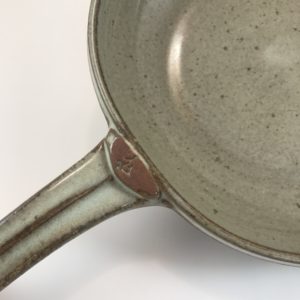Here it is: new CERAMIC FLAMEWARE from Clay Coyote Pottery. It’s ceramic cookware for stovetop cooking! We’ve spent nearly 2 years working on this to get it right…
It started a couple of years ago as Paula Wolfert was looking for a source for pots to emulate some of the indigenous cookware traditionally used over open fires and charcoal. trouble is, our modern stoves have much higher heat.
A few potters have made stoneware flameware over the years, but conventional wisdom was that it was risky and devilishly difficult.
Well, we can attest that it’s difficult, but after cooking with a number of pieces over the last 6 months, and recruiting a number of our friends to do the same, it’s ready for you.
 The first piece is this skillet…
The first piece is this skillet…About 10 inches in diameter and 2 inches deep. Fry, saute, bake, roast…do just about anything. Good in the microwave, cleanup easily in the sink or dishwasher. Tom’s used it for eggs almost every morning for 5 months and finds it has much less of a tendency to burn food, and the eggs are more tender that in metal cookware.
Betsy’s been doing the same with oatmeal every morning in a small saucepan and with the same result.
Paula’s been doing a lot of work on cooking in clay, as she has for years, and has decided that it’s the way to go. “These are absolutely fabulous” she says.
Next was a cazuela, about 11 inches in diameter that Paula needed for gratins and some other dishes started on the stovetop, and finished in the oven. This one’s got a smaller ‘trumpet’ handle with a small ‘hot-pad tab’ on the other side for easy handling in and out of the oven. Betsy just used one to make an apple tarte tatin.
We’ve done a couple of saucepans but are just finalizing sizes and shapes. Finally, we did a 3 qt. casserole for Paula, and she found it made the best daube ever and that it cooked simmered dishes better on the stovetop than any crockpot does.
We aren’t sure why these ceramic pots cook so well (and clean up even better). After a lot of testing, we think that it’s because the ceramic is an insulator, heat comes through more gently, so food has much less tendency to burn, even slightly. The secret, though, is to slow down, put the heat where you’ll need it eventually, and then wait for the pot to warm up. If you punch in high heat initially, the heat keeps coming through and can overcook the food. You also have to learn to either turn the heat down or off earlier, or remove the food as soon as it’s done. But these pots go from stove to table so beautifully that the turn down early is the way to go.
Right now glazes are limited to the one blue-gray shown. We’ll have more later, but never the same as our regular glazes. The clay that makes these pots possible limits the glaze possibilities.
